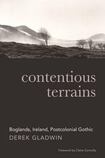
"Ya know this auld bog, always shiftin' and changin' and coddin' the eye." So says Monica Murray in Marina Carr's play, By The Bog of Cats. In Contentious Terrains, Derek Gladwin attempts to track this shifting and changing landscape of the bog as it appears through Irish literature of the 20th and early 21st centuries. It's an ambitious study that covers questions of nationhood, colonialism, gender, ecology and more. What links the somewhat disparate group of writers under the microscope is that which Gladwin describes as their ability to "adopt both a literal and symbolic sense of the bog". While the links between, say, Bram Stoker and Tim Robinson might not be immediately obvious, Gladwin finds a common sense of purpose and commitment in their respective engagements with the marginal and ill-defined country of the bog.
Though separated by almost a hundred eventful years, both Stoker and Robinson provide clear examples of Gladwin's primary concern: the multifaceted intersection of the political, the ecological and the imaginative in the terrain of the bog. Stoker's 1890 novel The Snake's Pass chronicles various attempts by Anglo-Irish landowners to exploit a patch of blanket bog on the west coast. Seeking treasure both in and under the bog, they ultimately destroy it. While the novel isn't exactly an ecologically activist book, Gladwin highlights how "it serves as a warning by subtly questioning the problems associated with exploiting and then developing boglands for profit rather than subsistence". This is a theme that Robinson has picked up many times in his work, not least by playing a part in saving Roundstone Bog – one of the very few remaining Atlantic blanket bogs – from having an airport built on it. His Connemara books, particularly Listening to the Wind, provide a detailed exploration of – and advocacy for – the ecological and cultural vitality of these oft-unloved places. For Stoker and Robinson, and Gladwin too, the future of the bog is as crucial as the history, the "treasure", which it retains.
Anglo-Irish landlords
The difference between the bog exploitation in Stoker and Robinson’s work is that, for the former, such work was carried out by Anglo-Irish landlords. In Robinson’s time, those efforts are essentially indigenous and pursued under the banners of tourism, “modernisation” and wealth-creation. This distinction is one of Gladwin’s central arguments: though the English are gone, the colonial approach to productive exploitation remains, often at the expense of the idealism which fuelled revolutionary ideas in the first place. In Gladwin’s eyes, the bog serves both Frank O’Connor and Seán Ó Faoláin as an ambiguous, haunting setting – a place where the nationalist fervour of the past can be complicated with accounts of the violence and destruction latent within it. It can be further contrasted with the petty, reactive nationalism of Ireland in the 1930s. Gladwin applies a similar lens to Seamus Heaney’s poetry during the Troubles, but the reading is too stiff and simplistic to achieve the same effect. Heaney’s work during this time is, as Gladwin admits, frequently examined, and so more difficult to illuminate.
Contentious Terrains is best when looking at Carr's By The Bog of Cats and Deirdre Kinahan's Bog Boy, two plays which forcefully stage the social conflicts at the heart of Irish society before and after the Celtic Tiger. For the women in both plays, the bog is an escape from the demands of the domestic scene. Even as they are refused their right to self-determination by the strictures of a conservative society, they in turn refuse the roles of compliant wife, child-minder and home-maker. In both cases, the painful stasis results in self-destruction. Gladwin is right to see Carr's tragic climax as a reassertion of female control, and his delineation of the many ways Carr and Kinahan's characters are trapped and let down by the patriarchal State is impressive. That he expands this reading into the political space of theatre-making through the Waking the Feminists movement is equally so.
Imaginative terrain
Gladwin ultimately sees the bog as a place where the contradictions of “modernisation” – from the fight for independence to the cheap money days of the Celtic Tiger – can be played out. The bog serves as a place where the people whose narratives do not fit the picture of national progress can stake a claim, even if only temporarily. This is why the bog is a “contentious terrain” – it challenges the status quo, the received wisdom, the blissful ignorance. The bog is a place where that which would be forgotten, excluded, disposed of can return to haunt those in positions of power. As both literal and imaginative terrain, the bog refuses to be seen from a single perspective. It is temporally, ecologically and socially varied. As Gladwin ably demonstrates, the bog insists on the complexity of the past, and its vital, ghostly presence in the present.









